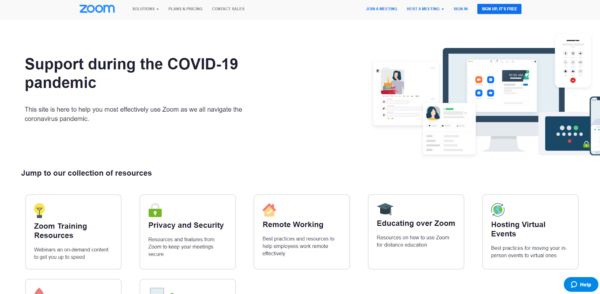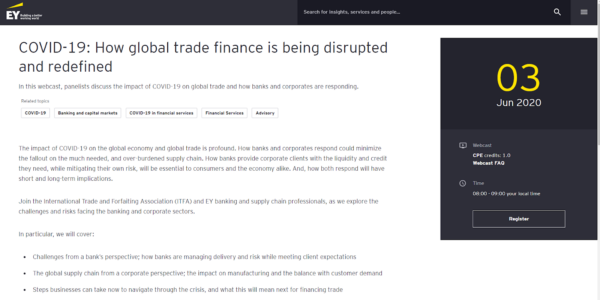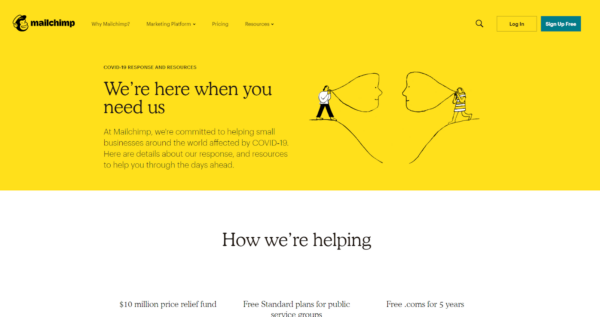For more than a month, I’ve been writing content to help digital marketers keep on keeping on. Just because we’re in a crisis doesn’t mean that money stops.
And if yours is one of the many businesses creating coronavirus-related content right now, you know you’re striking a delicate balance.
You want to share your products and services that could help consumers during this difficult time. But you don’t want to seem too opportunistic — or have an ineffective campaign after all this hard work.
Here, I’ll share some landing page best practices that will work even during a pandemic. I’ve also curated some examples of some web pages that are hitting home runs.
First, let’s discuss what a landing page really is.
The Basics of Landing Pages
Businesses create landing pages for specific marketing campaigns. They can stand on their own, and don’t necessarily interlink with the rest of the site.
Usually, landing pages have fields where users can fill in their personal information. This becomes part of an email list that the business uses to grow their audience and implement an email marketing strategy.
What can I use a landing page for?
You can use a landing page for whatever you want.
Have an eBook you want to share? Create a landing page with a preview of the book and an email form to download it.
Hosting an upcoming webinar? Create a landing page for attendees to register.
Start a new branding campaign? Create a landing page with campaign collateral and copy that explains your new angle.
Why do I need landing pages?
Having a standalone page for a campaign or piece of content makes it simpler to track. You can more easily see how users got to the page and with what intent.
Of course, you could always link an ad to an evergreen page. But this can confuse users.
When someone clicks on an advertisement for a specific campaign, they expect to go to a page that’s simple and directly relates to the ad itself. This could be a simple splash page or a well-organized collection of resources.
But if your ad just links to a longform content page, users may get confused. Then you could miss out on a quality lead.
That’s what makes landing pages so necessary.
However, when it’s about coronavirus, things may get a little more complicated.
How to Make an Effective Coronavirus Landing Page
Use the right software
The right software can make or break a landing page. Plus, the software determines how easy it is for you to create one.
Growth Marketing Pro reviews and compares the most popular landing page software out there. Find the one that’s right for you so you can create your new landing page ASAP.
Take a hybrid approach
Many recently-created coronavirus landing pages are more of a hybrid between landing pages and pillar pages. They’re longer and have more links than the usual landing page, but more concise than an exhaustive pillar page.
This type of page allows you both to draw customers in and ensure they have the coronavirus-related info they were looking for.
Two examples below – one from Zoom and one from Mailchimp – show exactly what I mean.
Link to updated resources
This has to do with both ease of access and empathy. If you recently added a ton of coronavirus resources to your site, link to them here.
This not only shows that your business is stepping up its content game, but also that you care about giving the right info to your audience when they need it most.
Zoom did a great job of this with their hub page for coronavirus-related content. This page covers important topics that users search for.
Plus, you can see that they didn’t have to create that much all-new content to keep the page relevant. Although some of the blog posts they link to are undoubtedly new, the topics they grouped together can stand on their own during or after COVID-19.
For example, they have a section of this page dedicated to Zoom training resources. Is this relevant now, when many people have to learn how to use Zoom so they can keep working during coronavirus? Yes!
But is it solely relevant during this time? Not at all! These Zoom trainings are always available.
The thing that makes this page great isn’t that every resource is COVID-specific. It’s that all of the resources here are things that people working through the pandemic may look for.
Take this as reassurance that you don’t have to drop everything and create coronavirus content. To attract your target audience right now, a landing page simply has to give people what they need.
If you want to go the extra mile, include links to COVID-19 resources from the government. It has more to do with health and laws than your business, but it shows users you care about giving them all the info they need, even if its not yours.
Stick to your usual branding
Going wildly off-brand to focus on coronavirus-related topics will almost definitely make your business seem opportunistic. During an international crisis like this, that’s an especially bad look.
Use the same style as your other landing pages. Keep things simple. It’s easier on you, and more palatable for consumers.
EY’s COVID-19 webinar page is a good example of this principle. They didn’t go all-in on a coronavirus theme or change their branding in any way.
“But Hailey,” you may say, “isn’t this whole article supposed to be about how to change my landing pages during coronavirus?”
Well, yes and no. Some aspects of your landing page strategy should change. The general look and feel of your landing pages should not.
There are two reasons why you should stick with your usual designs and branding:
It shows brand consistency
You want your brand to project strength in the face of a crisis. Changing your branding and altering your core principles is doing the opposite.
It invokes a much-needed sense of normalcy
Consumers want things to go back to normal. This is scary. We don’t know what the new normal will be, or even when it will happen.
If someone knows your brand and sees a landing page fully made over to represent coronavirus, it may be off-putting.
Stick to your usual branding and give the audience something they’re used to.
Don’t make a hard sell
Now is not the time for sales-y pitches or overly-cutesy copy. Fewer people are willing to make a purchase right now, anyway.
Instead, focus on gathering leads, providing useful information, and showing empathy.
Mailchimp’s COVID-19 resource page shows more than empathy. In the “How we’re helping” section, they highlight specific actions they took to make the effects of coronavirus easier for their customers to handle.
At the very bottom of the page, they have a newsletter signup form. This page is a super-soft sell meant mostly for branding.
For potential customers, this coronavirus hub page shows the human side of Mailchimp and reflects positively on the company. For current customers, this page gives easy access to relevant resources.
Additionally, the copy on this page is caring without being too cheesy. People see through phrases like “We’re all in this together” or “Help us help you.” This kind of copy makes it seems like you’re faking it.
“We’re here when you need us,” on the other hand, takes a different tone. The phrase recognizes that the Mailchimp brand isn’t your BFF, but shows that the business is compassionate toward its customers.
Final Thoughts
So many digital marketing staples — landing pages included — changed because of the pandemic. Your company may find it hard to keep up with the constant changes.
You may have wondered what the point is if you don’t have newsy, COVID-related content to share. Hopefully, after reading this, you see that you don’t need this content.
For a landing page to work right now, you just need a slightly altered strategy and a willingness to connect consumers with the right resources.
Remember the basics, stay empathetic, and put customer needs first. Effective landing pages will follow.


